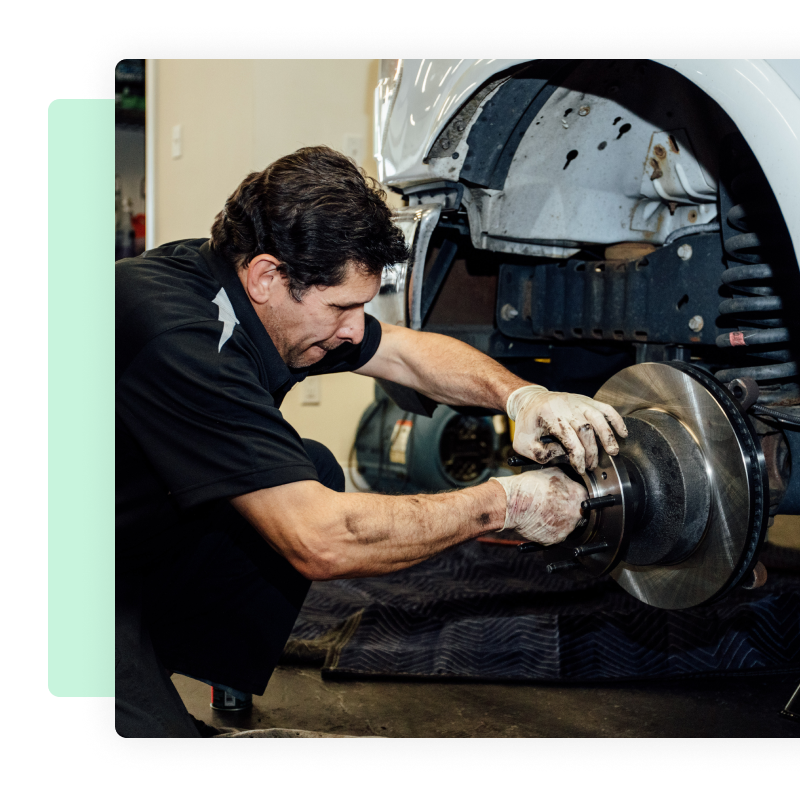A Technician’s Take: Firsthand Tips on Retaining Mechanics
According to the Bureau of Labor Statistics, the US will need more than 60,000 new automotive technicians every year until at least 2033. To fill those roles, it’s imperative that fleets understand what technicians want from their jobs.
Jul 18, 2025
6 min read

Content Overview
This blog highlights firsthand insights from an experienced fleet technician on how to attract and retain skilled talent. Key recommendations include easing the financial burden of tool investment, promoting work-life balance, and fostering a respectful, supportive workplace culture.
While much has been said about the technician shortage facing America and how best to combat it, few discussions center around what actual technicians have to say on the topic. To help correct that, I recently interviewed Michael Hairston, a maintenance technician at Life Ride, New Jersey’s largest ambulance and wheelchair transport company.
Among his colleagues, Michael is known for his dedication, willingness to mentor newer technicians and knack for making processes more efficient. Last month, those traits earned Michael the grand prize of Fleetio’s Automotive Service Excellence (ASE) Scholarship program. To further expand his skillset, Michael intends to use his winnings to become ASE-certified on electrical systems (among other specializations).
So what does an exceptional fleet technician think organizations should do to attract and retain talent? Here were his recommendations:
1. Meaningfully address the cost of tool investment
When a recent survey asked technicians to select the biggest challenge facing newcomers to the field, a third of respondents selected tool investment. For aspiring technicians, having to drop thousands of dollars on tools before their first day of work can be a major hurdle. And while tool allowances can offset that expense, they’re often more of a Band-Aid than a cure.
I’ve worked in a few places where we had tool allowances… But, at most, I think I got about $500… And, depending on where you buy your tools, $500 can be one tool. Michael Hairston, Technician at Life Ride
To truly make tool investment less of a barrier to entry, fleets should make sure that any allowances they give are reflective of current tool costs. Prices have risen across the board in recent years, so allowances set even five years ago are woefully out of date by now.
Alternatively, fleets can lend starter toolboxes to their new hires. While more of a cost for employers, by awarding ownership of the toolboxes upon reaching a milestone (e.g. two years on the job, getting some number of certifications, etc.), fleets can provide a retention-boosting incentive for sticking around for the long haul.
Running your shop on coffee and chaos?
We can fix that. Fleetio helps your team stay connected and on task — assign work orders, track labor, manage parts and keep every repair on schedule and out the door.
Let's get after it2. Maintain a healthy work-life balance
While burnout is a concern for every profession, the issue is particularly acute among technicians. According to research by WrenchWay, 69% of technicians have reported feeling depleted by their work to some degree. And while many factors can contribute to that exhaustion, misaligned work-life balance is a leading cause across the industry.
[Fleets] need to understand the importance of having a work-life balance. A happy employee is a better employee. Michael Hairston, Technician at Life Ride
By making a deliberate effort to keep productivity expectations realistic and overtime to a minimum, fleets can go a long way towards maintaining a healthy work-life balance in their shops. Depending on a fleet’s circumstances, achieving that balance may require bringing on additional technicians or implementing new management tools.
But, as Michael pointed out, investing in your technicians’ job satisfaction is a win-win scenario. Greater technician contentment results in greater productivity, less turnover and better adherence to shop safety protocols. And, in the long run, all of those benefits have a positive impact on a fleet’s bottom line.
3. Invest in technician upskilling
Whether it’s developing new skills or attaining new titles, people in all lines of work aspire to continually advance in their career. Technicians are no exception to this.
Fleets can show they value this drive by asking technicians about their goals and developing personalized plans to help them realize those ambitions. For many, achieving their desired results will require additional technician education or training. By covering education-related expenses, providing internal training or setting up mentorships, fleets can nurture technicians as their skill sets expand.
As a basic example of this, many fleets offer wage bumps to technicians upon receiving relevant certifications. These fleets also often pay for registration and testing fees associated with attaining those certifications.

By actively supporting the career development of their technicians, fleets benefit twofold. First, more skilled technicians are often more productive technicians. And second, technicians who receive such support are far more likely to stick around for the long haul.
4. Foster a positive working environment
I think happier employees or more-appreciated employees are willing to go further than someone who’s always getting reamed out or yelled at. Michael Hairston, Technician at Life Ride
While this last recommendation should go without saying, survey data suggests some public service announcements might be needed. When WrenchWay asked technicians if they’ve ever left or considered leaving a job due to their boss, two-thirds of respondents said yes. And when America needs more technicians than ever, losing folks due to poor managerial conduct is a shortcoming the fleet industry can’t afford.
Anonymous employee feedback surveys can help fleets address this issue. By providing technicians with a discrete way of communicating their thoughts, you can gain a new perspective on what your technicians contribute to your organization. And while resolving disagreements isn’t always easy, simply identifying what rubs people the wrong way can be a big help in establishing a more harmonious workplace.
How software can eliminate common pain points for technicians
Michael became a technician because working on vehicles has been a passion of his from an early age. For him (and most of his peers), wrenching is the best part of his job. Anything that gets in the way of that is a hindrance.
By digitizing their operations with fleet maintenance software, fleets can eliminate the cumbersome paperwork that prevents technicians from doing what they enjoy most. With the right FMS, printing out work orders and pencil whipping become things of the past. Digital work order tracking dramatically streamlines how technicians receive, document and review their work. As a result, technicians spend less of their day fussing with paper forms and more time wrenching.
Additionally, fleet management systems (FMSs) make it easier for managers to measure any individual mechanic’s performance. This can help managers identify technicians who might benefit from mentorship or additional training.
By rolling out software that makes their technicians' duties easier to manage (in conjunction with empathetic retention strategies), fleets can significantly improve their employee retention.
Safety isn't just a slogan
Posters don’t prevent breakdowns or protect your drivers, your process does. Fleetio gives you real-time visibility to catch safety issues early, complete inspections and stay on top of PMs and recalls — so your team stays safe, your fleet stays compliant and nothing falls through the cracks.
Find out more
Fleet Content Specialist
Through interviews, blog posts and webinars, Alex covers the tactics and technologies exceptional fleet managers use to achieve results. By sharing their success stories, his work aims to inform and inspire fleet professionals of all stripes.
LinkedIn|View articles by Alex BorgReady to get started?
Join thousands of satisfied customers using Fleetio
Questions? Call us at 1-800-975-5304
Get Our Newsletter
Join a community of 70,000+ fleet industry professionals.

